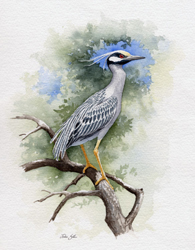Breeding Bird Atlases (BBA)
Find a Bird - BBA1
Breeding Bird Atlas 1 Species Accounts
Yellow-crowned Night-Heron
Nyctanassa violacea
Egg Dates
April 30 to June 10
Number of Broods
one; may re-lay if first attempt fails.

The evidence supporting the placement of the Yellow-crowned Night-Heron among the breeding avifauna of Massachusetts is minimal and, in some cases, tenuous. Incubating adults or nests containing young have been recorded on only two occasions during this century. Townsend secured one of four nestlings in Ipswich in 1928, and Hagar documented breeding birds in Marshfield in the late 1940s. Other purported breeding records are at Provincetown in 1891 where adults were present and an immature was collected in July, and at Chatham in 1940 and 1941 where Maclay noted nearly fledged young (Hill 1965). The continued presence of adult birds at the same location for successive years during the nesting season is strongly suggestive of breeding but lacks the necessary evidence for confirmed breeding.
Migrant Yellow-crowned Night-Herons normally appear in the state in mid-May, but there are a number of April reports. Occasionally during spring migration a stray individual may appear in wooded swamps or trees bordering meandering streams at inland locations. Otherwise, they inhabit coastal bays and marshes and are most frequently encountered in southeastern coastal areas, Cape Cod, and the Islands. Throughout most of the twentieth century, the Yellow-crowned Night-Heron has been a very uncommon or rare resident. Adults are often found in potential breeding locations from June through August. The appearance of immature birds, often in the company of adults, is indicative of breeding. However, since herons, most notably young of the year, undertake extensive postbreeding dispersal northward, the origin of these immatures from breeding colonies on Long Island or farther south cannot be discounted.
During the 1960s and 1970s, southern herons spread dramatically northward and established breeding colonies in Massachusetts and Maine, areas where they had not been known to breed or bred only in limited numbers. This group included Great, Snowy, and Cattle egrets, Tricolored and Little Blue herons, and the Glossy Ibis. However, there is no evidence that the Yellow-crowned Night-Heron shared in this range extension since its status remained relatively unchanged.
Yellow-crowned Night-Herons breed widely from the southern United States, the Caribbean, and Middle America south along the coast to central South America. In the United States, they breed at interior locations along the lower Mississippi River drainage, along the Gulf Coast, and north along the Atlantic coast to Massachusetts. They usually nest in small to large mixed-species colonies, but, at the northern periphery of their range, they frequently nest in isolated solitary pairs. On Long Island, Yellow-crowned Night-Herons breed both in mixed colonies with other herons and alone in wooded swamps. Yellow-crowned Night-Herons have yet to be discovered in any of the heronries that have been surveyed periodically since the late 1970s. Hagar discovered them as solitary breeders, and it is likely that this remains the case at present.
Nests are usually located 15 to 45 feet above the ground in a live tree. The nest is a rather large, well-built platform of heavy twigs and is often lined with leaves or grasses. Pair bond formation involves rituals as with other heron species and includes “stretch displays,” “circle flights,” “billing,” and “allopreening” (Palmer 1962).
Normal clutch size in temperate regions is four or five, but sometimes as many as eight eggs are laid. Incubation is by both parents for approximately 21 to 24 days. Nest relief is sometimes accompanied with “billing” and “feather nibbling” or other displays. The young are altricial and soon after hatching are covered with gray down. Both adults feed and care for young. The young apparently fledge at about three and one-half weeks.
After nesting, birds assemble in communal roosts, often with Black-crowned Night-Herons. During the breeding season, they seem to be much more diurnal than Black-crowned Night-Herons, a fact that may be due to a difference in their method of feeding. The heavier, stouter bill of the Yellow-crowned Night-Heron enables them to feed primarily on crustaceans, especially crabs. Black-crowned Night-Herons consume mainly fish. The diurnal feeding habits of Yellow-crowned Night-Herons are closely tied to tide cycles since they tend to feed at low tide on the edges of flats or along creeks. Hagar pointed out that Yellow-crowned Night-Herons bred in Marshfield when crabs were especially abundant.
The single “probable” breeding record during the Atlas period was in Centerville where a recently fledged young was found in an area where adults were observed feeding routinely over a period of several years. Other locations where adults were found regularly during the breeding season were Westport, Eastham, Marshfield, and the Plum Island area. More recent suspected breeding areas are Hingham and Wareham.
Yellow-crowned Night-Herons routinely linger until mid-September, at which time they, along with other herons, undertake an unheralded departure for more southerly climes. Yellow-crowned Night-Herons are rarely encountered in October, and there are only a few winter reports.
Map Legend and Data Summary
Atlas 1 data collected from 1975-1979


Note: very rare and local along coast; may be a solitary breeder in Massachusetts
Richard A. Forster



